Cascais-Portugal.com
The best independent guide to Cascais
Cascais-Portugal.com
The best independent guide to Cascais
Cascais to Sintra
Sintra is a fascinating town with lavish palaces and stunning natural scenery, which makes for a fantastic day trip from Cascais. Conversely, Cascais is one of the finest resort towns on the Lisbon coastline and offers some of the most easily accessible beaches for visitors based in Sintra.
Sintra is easily accessible from Cascais via regular bus services or ride-hailing apps such as Uber or Bolt. These options eliminate the hassle of changing trains in Lisbon or attempting to drive through Sintra's notoriously narrow streets, where parking is virtually impossible.
This guide will detail how to travel from Cascais to Sintra (and vice-versa) using public transport. It includes fares, timetables, and station information, as well as details on alternative travel methods.
Related articles: Sintra Introduction - Day trip to Sintra
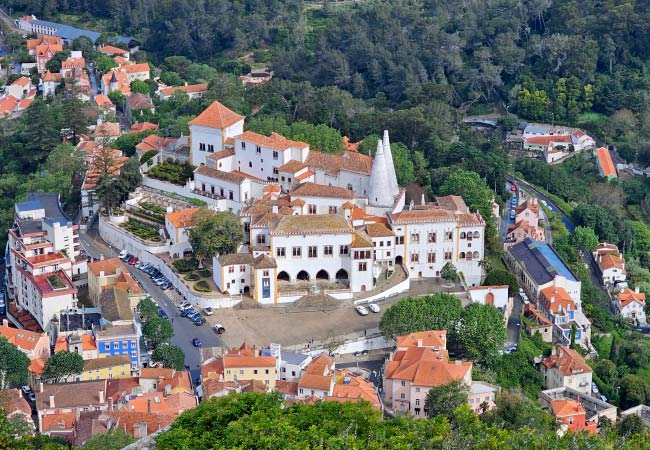
Cascais to Sintra by Public Transport
Sintra lies 17km north of Cascais and is connected by both rail and road public transport. The rail route is impractical because it requires two journeys, one from Cascais to Lisbon and a second from Lisbon to Sintra. The Cascais Sintra bus route is direct and is the recommended means of travel between the two tourist towns.
Cascais to Sintra by Bus
There are two bus services which connect Cascais to Sintra, service number 1623 and 1624. Both routes start at Cascais bus station (Cascais Terminal) and terminate at Portela Sintra.
Bus 1623 (The direct route): This is the faster service, with a journey time of approximately 30 minutes.
Bus 1624 (The scenic route): This service takes a longer, more scenic route along the coast, passing the spectacular Cabo da Roca cliffs. The journey takes around 60 minutes.
Insight: All bus services in the metropolitan area of Lisbon (including Sintra and Cascais) are operated by Carris Metropolitana. This changed from Scotturb in Jan 2023, and may still be mentioned in some tourist guides. Scotturb still operates all of the tourist bus services in Sintra, such as the 434 to the Palácio Nacional da Pena.
Bus Fares and Timetables
A single cash fare, purchased from the driver, costs 2.60. You will need cash as card payments are not always accepted on board.
For a cheaper fare, use a Navegante card. This is the rechargeable public transport card for the entire Lisbon region. With the Navegante card, the journey costs just 1.55. The card itself costs 0.50 to purchase from any train or metro station ticket machine and can be topped up with credit. It's a fantastic money-saver if you plan on using public transport frequently.
The bus services depart roughly every 30 minutes during peak times. For the latest timetables, please consult the Carris Metropolitana website:
www.carris
(Note: you want to search for line 1623)
On the website, 'Dias úteis' means Monday to Friday, 'Sábados' is Saturday, and 'Domingos e Feriados' means Sundays and public holidays.
Bus stops
In Cascais, the bus departs from the main bus station (Cascais Terminal), which is located below the Cascais Villa shopping centre (GPS: 38.700, -9.418). For visitors arriving in Cascais, this is close to the town centre and a 5-minute walk to the Praia da Duquesa, the main beach of the town.
In Sintra, the bus terminates at Portela de Sintra (GPS: 38.802, -9.376), which is in the modern part of town with its shops and services. This is not the historic centre that is the main tourist draw.
From Portela de Sintra, you face a substantial 2km walk to reach the historic centre and the iconic Sintra National Palace. The major attractions, such as the Pena Palace, the Quinta da Regaleira, and the Moorish Castle, are even further up the hills.
To reach these sights, most visitors connect to the 434 tourist bus, with one route departing from the Portela de Sintra train station.
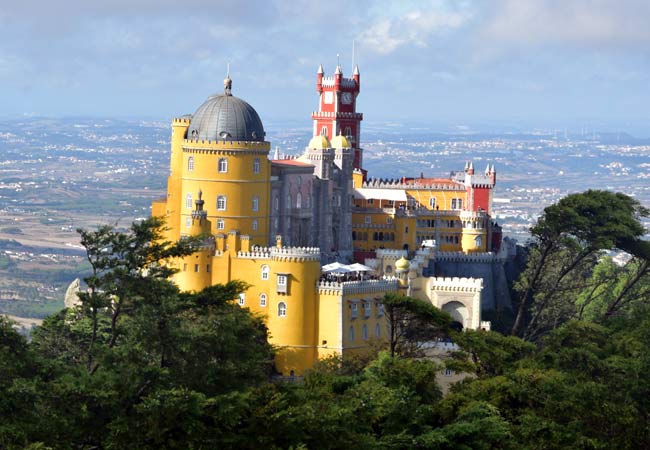
Taking Uber or Bolt from Cascais to Sintra
Ride-hailing apps like Uber and Bolt offer a convenient alternative to the bus, particularly if you're travelling as a group or prefer a door-to-door service. The journey typically takes 25-30 minutes and costs between €15-€25, depending on the time of day and demand.
During the peak tourist season and on weekends, expect higher fares due to surge pricing. Availability can also become limited as drivers concentrate on the busier Lisbon routes.
The main advantage is being dropped directly at your chosen destination in Sintra, whether that's the historic centre or one of the major palaces. This saves you from having to connect to the 434 tourist bus and can be particularly valuable during busy periods when the tourist buses get crowded.
For the return journey, booking a ride from Sintra can be more challenging, especially at peak times.
Insight: If you plan to use Uber or Bolt, it is advisable to download the app, register, and become familiar with it before you use it.
Cascais to Sintra by car
Driving from Cascais to Sintra is strongly discouraged.
The roads climbing into the Serra de Sintra hills were built centuries ago for horse-drawn carriages, not modern cars and coaches. These narrow, winding routes create bottlenecks that result in lengthy traffic jams, particularly at weekends when the area is flooded with day-trippers. What should be a 30-minute drive can easily stretch to over an hour during peak times.
Parking presents an even bigger challenge. There is no parking whatsoever at the Pena Palace, and the roads leading to both the Pena Palace and the Moorish Castle are completely closed to private vehicles. Only taxis, Uber, Bolt, and the official tourist buses are permitted access to these hilltop attractions.
The main public car park for Sintra is located near Portela de Sintra train station (GPS: 38.800, -9.381) From the car park, you'll still need to catch the 434 tourist bus to reach the major sights, negating any advantage of having brought your car.
Even parking in the historic centre is severely restricted, with just a handful of spaces that fill up early in the morning. The combination of limited parking, traffic congestion, and restricted access to the main attractions makes public transport the far more sensible choice for visiting Sintra.
Travel by Train from Cascais to Sintra
Travelling from Cascais to Sintra by train is unnecessarily complicated and time-consuming. It requires:
• A train from Cascais to Cais do Sodré station in Lisbon.
• A transfer across central Lisbon to Rossio train station (via metro or a long walk).
• A second train from Rossio to Sintra.
This entire journey takes over 90 minutes and costs significantly more than the direct 35-minute bus ride.
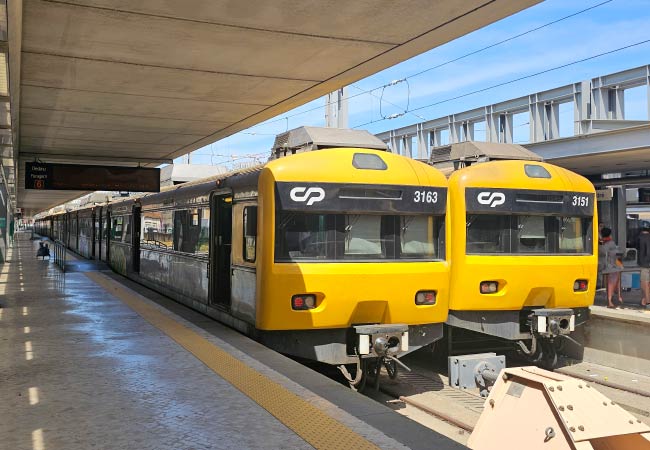
The 434 Tourist Bus in Sintra
Upon arriving at Portela de Sintra, you will be some distance from the main palaces, which are located high in the hills. While the walk to the historic centre is manageable, the climb to the Pena Palace and Moorish Castle is very challenging.
The easiest way to explore is by using the 434 (Circuito da Pena) tourist bus. This bus service follows a one-way loop connecting the train station, the Moorish Castle, and the Pena Palace, the historic centre, before returning to the station.
The bus is quite pricey at €13.55, but is cheaper than taking a tourist Tuk-tuk, or waiting a long time for an Uber – Uber drivers dislike this journey due to the heavy traffic.
During the summer, queues for the 434 bus can be very long. It is always advisable to start your day trip early.
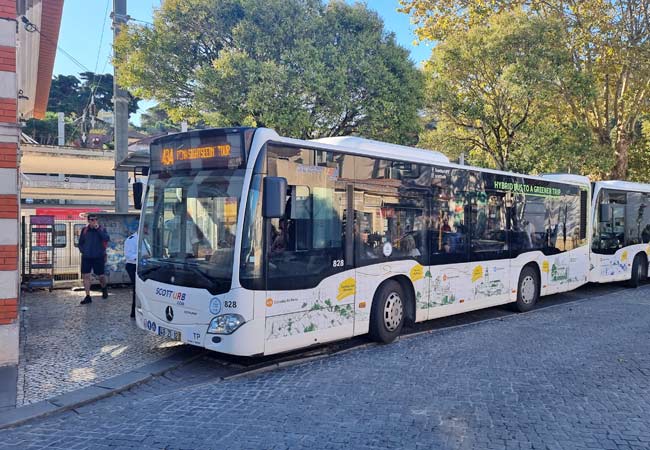
Can I see Sintra and Cascais in one day?
Certain visitors who will be reading this article will be planning a trip to both Sintra and Cascais in one day. This is not recommended.
There is too much to possibly see in one day, and a significant portion of the day will be spent waiting for public transport. Driving to Sintra would be even worse, as the narrow roads are not designed for the heavy tourist traffic and there is simply no car parking.
These are both historic and wonderful towns with a vast amount to see, and give them the justice that they deserve (Sintra two days, Cascais one day). If you are really pushed for time, consider joining an organised tour, but do not plan both destinations as a one-day trip.
Cascais Sintra, Cabo da Roca Bus Stop
Along the 1624 bus route are the Cabo da Roca cliffs. This headland is the most westerly point of mainland Europe and was thought to be the end of the known world in the 14th century. The region is of dramatic landscapes, 150m high cliffs fall away to raging seas and the entire region is buffeted by strong winds. Cabo da Roca is a beautiful location for people who appreciate nature's raw beauty and is a wonderful place to watch sunset, but unfortunately the bus times do not allow for this.
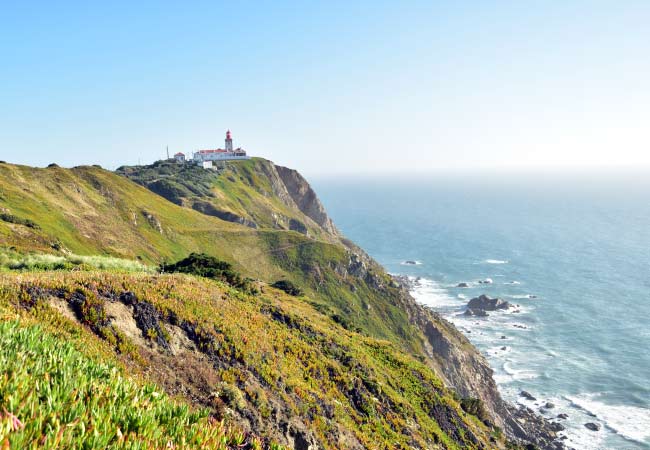
If you've found our content valuable, we'd welcome your support.
The digital publishing landscape has evolved significantly. As a small independent publisher, we face growing challenges. Search engines increasingly favour paid content over organic results, while AI-generated content often reproduces original work without attribution.
To support our work, please consider bookmarking this page (press Ctrl + D) for quick access. If you find an article helpful, we'd be grateful if you'd share it with friends on social media.
For specific questions, please see our Reddit community at r/LisbonPortugalTravel.
Should you notice any outdated or incorrect information, please contact us at [email protected]
Thank you for helping us continue to provide valuable content in an increasingly challenging digital environment.

























